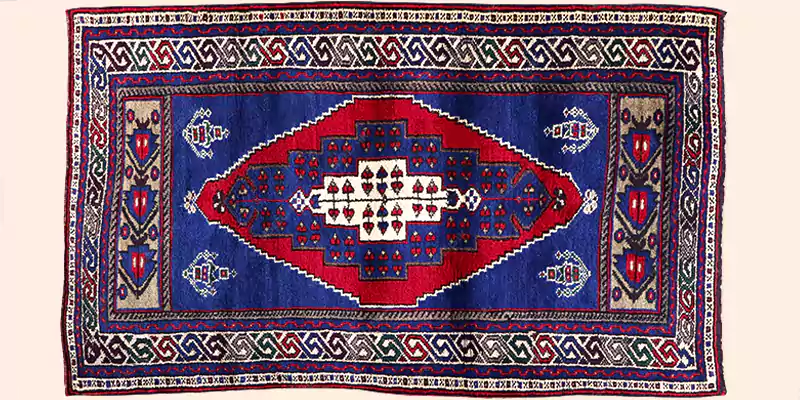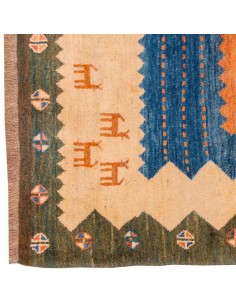- Mahsa S. Y.
- Rug & Carpet
- 766 views
- 6 comments
Gabbeh is a type of flooring, like its counterparts, such as carpets, rugs, Jajim, Zilo, etc. Therefore, Gabbeh is one of the types of flooring. Gabbeh, Gebbeh, or Geba is also called khersak. Khersak or Gabbeh rug is made of wool, usually woven in a small size by the Lor and Qashqai tribes in Persia. Gabeh Rug has attracted countless fans all over the world today. This blog post will introduce Gebbeh, its history, specific sizes, characteristics, and features. Finally, we will review the benefits of Gabbeh.
What is Gabbeh?
Gabbeh has long piles, and numerous wefts are used in its texture, which has a significant effect on its softness. The number of wefts of some Gabbeh s is sometimes from three to eight wefts in each row, and the length of the bristles sometimes reaches up to one centimeter. For these reasons, the average weight of Persian Gabbeh rugs is 3 kg per square meter.
The meaning of Gabbeh has changed over time. Currently, this word means thick and rough. Sometimes, the word Gair, which means protector, has also been attributed to it. But it is said that this word initially means raw, natural, or untouched. Also, the word khersak means a bear cub, and the reason for this name is the heavy weight of this type of rug compared to its small size.

The History of Gabbeh Rug
It can be said that the history of the creation and production of Gabbeh goes back to the time of early humans because they used the skins of different animals as their underlays, and over time and by gaining experience, they were able to produce the first woven underlays from the wool of domestic animals. One of them is Gabbeh.
The Main Origin of Gabbeh
Gabe is mainly the art of the nomads of different regions such as Bushehr, Shiraz, Khorasan, etc., and it is considered one of these people's main assets. Fars province in Persia has more than 350 years of history in organizing Gabbeh weaving. Known as one of the pioneers of this art in Iran. This region includes the tribes of Qashqai, Khamsa, Mamsani, and Bakhtiari. Among the other vital centers of Gabbeh are Do Gonbadan, Basht, Tal Gar, Cheshme Belqis, Deh Sheikh, and Cheram in the city of Kohkilouye, Deh Alia, and Deh Sefali Alia, Barazjan and the rural districts of Shul and Deh Kohene in Bushehr province.
What is Kashkuli Gabbeh Rug?
According to the historical documents and the latest family information, the Kashkuli Gabbeh rug with the design and pattern of the current, named as fishes, and called the old Kashkuli Kermani design, was first produced in 1230 AH (1850 AD) by the daughter of an artist named Nagar (Nagar I) Karim Kermani's daughter, patterned and woven. At that time, weaving Persian rugs was common in their family, and they had incorporated the best Gabbeh rugs. Undoubtedly, this art reached its peak at that time, but the roots of its texture were old, so there was a need for more information about the records before that.
After that, the pattern of Nazem from Kashkooli Gabbeh rugs in 1260 AH (1880 AD) was modeled by an artist and educated daughter of the fifth generation of the Kashkoli family named Nagar (Nagar II), the daughter of Haj Bahram Kermani. The entrance gate of one of Shiraz's famous gardens is woven. Of course, Kashkouli's projects have many historical records. Negar III and his husband have also been engaged in the same job as an artistic-living work.
Cyrus Crafts; Luxury & Unique Products
In 1316 AH (1937 AD), he and his weavers, according to the order of Nasser Khan Qashqai and Hamza Khan Kashkuli, weaved two large fish Persian Gabbeh rugs together, and now the rug ordered by Nasser Khan Qashqai is kept in one of the London museums. The documents of their weaving order are still available in the Kashkouli family.
Khalil Mohammadi Kashkouli officially started to revive and produce the original designs of Kashkuli rugs by the women weavers of the tribe in 1340 (1961 AD). Also, he does a lot of research on the history and roles of Kashkuli Gabbeh rug and the production of its original samples, and he has worked closely with writers, researchers, and producers of documentary films on Qashqai rugs and handwoven.
Due to his great interest in Kashkuli Gabbeh carpets and his family's history of reviving them, as well as to motivate family members to continue this artistic activity, he named his two daughters Nazeme from the designs of Nazem Kashkouli and Negar (Nagar IV), has been named the first designer and creator of Mahi Darham Kashkuli. It should be noted that two other family members, Fatemeh Mehr Esalat in Qashqai rugs and Shirin Mehr Esalat in the field of fish Gabbeh Persian rugs, have obtained from UNESCO.
At the same time as the last years of Khalil Mohammadi Kashkuli's activities and also after his death, Behnam Mohammadi Kashkuli continued the production of Kashkoli Gabbeh and other Qashqai handwoven seriously and by participating in more than a hundred different domestic and foreign exhibitions, it has a lot of development to preserve and introduce and present them to the domestic and international markets.

Gabbeh Rug Common Dimensions
Gabbeh is woven in different dimensions, but usually, it is only incorporated in small dimensions. The cooperation of two weavers is required for one month, with six hours of work per day to weave each 100-200 cm. The usual size of Iranian Gabbeh is three by five feet. The duration of the mesh is directly proportional to the number of nodes. But for example, it takes about 18–25 days to weave a small 5×3 Gabbeh with a simple design.
Generally, most Persian Gabbeh rugs are woven in sizes of 6 meters; in Gabbeh weaving 2.25 × 1.5 meters and 1.5 × 1 meter rugs are common, too. In addition to creating a beautiful view in the house, this category of Gabbeh carpets also has a longer life and is very suitable and affordable in terms of price.
The Characteristics of Gabbeh?
Persian Gabbeh rugs have characteristics that distinguish them from other subspecies; the most important of these characteristics are:
- It has long bristles, and sometimes the height of the bristles reaches one centimeter
- It has a coarse texture and does not have delicate patterns
- It is soft and warm because of its long bristles
- It is woven from natural animal fibers such as sheep wool and goat hair
- For more softness, the hems have more wefts, 3 to 5 in each row.
- The type of gable knot is mainly Persian knot and sometimes Turkish knot
- Heavyweight. On average, each square meter of Gabbeh weighs 3 kg
- The texture is simple, or it has straightforward patterns
- It is not woven with a plan. Every weaver brings their mental plan to the canvas
- It is mainly woven by nomads and inspired by life in nature
- Persian Gabbeh rugs are sometimes woven simply without any predesign

The benefits of Gabbeh Rugs
If you want to collect information about different types of carpets, such as Gabbeh, to make an intelligent purchase, you want to know what advantages Gabbeh has. Here you are:
- Gabbeh is very durable due to its wool material and firm texture, and high-quality Gabbeh rugs have maintained their original beauty and attractiveness for several years.
- It has excellent comfort, which means the wool is very soft and comfortable due to its long piles and higher density.
- Gabbeh is very soft and thick, so it is ideal for people who want warm flooring.
- Gabbeh is dyed naturally; it does not contain chemical dyes, so it is not allergenic and poses no health risks to sensitive people.
- Gabbeh has a simple, minimal design and pattern that is not dull.
- Beds give a natural and pristine atmosphere to the arrangement and decoration of the house. With their soft material and unique and attractive patterns, besides making the house warmer, they significantly induce a sense of intimacy and simplicity.
- Walls are the best choice to add variety to home decoration and make the decoration more unique and attractive. Beds with modern designs are more suitable for contemporary styles, and beds with traditional designs, such as flowers, etc., are more compatible with classic styles. Standard designs can create a combined and stylish decoration along with modern items.
- In short, originality, beauty, and durability are among Gabbeh's beautiful features.
How to Identify a Legit Gabbeh Rug:
To be able to identify an authentic Gabbeh rug you need to look for a few key factors such as:
- Wool Quality: Real Gabbeh is made from the extra fine natural wool of the founders of the tribes of Iran and the nomadic tribes only. The wool ideally should be rather compact and fluffy and apart from that rather thick with silken reflections given by the weaving masters.
- Knot Density: Gabbeh rugs are not as compact in comparison with the other Persian rugs and the compactness of the pile of the Gabbeh rug is around 30 to 60 knots in a square inch. This means that the knobs per square are less and this is one of the aspects that has made the Gabbeh rug have a unique and irregular appearance.
- Irregular Patterns: Also it is mentioned that there are both symmetry and asymmetrical designs in Gabbeh genuine rugs and the design put on it is either drawn or painted by hand. Contrived does not attempt at a regular, let alone a perfect, sabbatical symmetry or repetition.
- Uneven Edges: Up-to-date these master weavers during making such a rug leave the natural tips of the wool, therefor, the outer edges of an authentic Gabbeh rug might be relatively irregular or slightly exposed.
- Natural Dyes: All genuine old Gabbeh rugs are made up of organic non chemical plant dyes and that is why they have some issues-like, problem of colour variation and shade difference in one and the same rug. The replicas preferably employ synthetic dyes; they are usually the counterfeits in the market.
- Fringes: This would be another reason to proceed with care, as the true Gabbeh rugs will always have thick woolen fringes at both ends of the rug due to their woven configuration.
Final Words
This article included a summary of the introduction of Gabbeh with details of its history, features, dimensions, and benefits of buying and owning Gabbeh. Please share your thoughts with us and other readers by posting a comment. If you have questions about Gabbeh and how to buy it, ask questions to the CyrusCrafts service center by clicking on the WhatsApp icon. Our experts will answer all your questions as soon as possible.



















Comments (6)